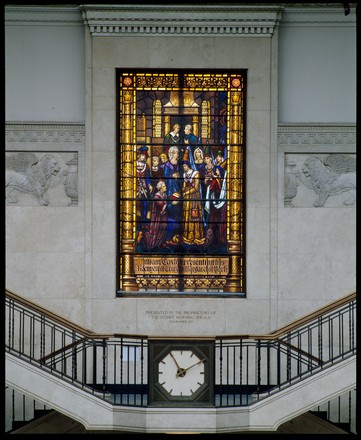Caxton window
for J Ashton & Co 1941
Presented by John Fairfax Ltd, 1941
Located at the southern end of the Mitchell Reading Room, this window honours William Caxton, who was the first English printer. The image shows Caxton presenting his translation of Recuyell of the Historyes of Troye to his patron Margaret of York, Duchess of Burgundy. The book is a collection of the stories or histories of Troy, which he distributed among friends and members of the Duchess’s court. Printed about 1474, it was the first book printed in English, most probably in the city of Bruges. His best-known book, Chaucer’s Canterbury Tales, was first printed in 1478. The Library holds a first edition leaf in its collection.
This design of the window was based on an old copperplate engraving found in a volume of the Recuyell held in the United States. The engraving is believed to show an authentic image of Caxton.
A master craftsman
Polish artist John Radecki was a master stained-glass designer known for his detailed compositions featuring bold colours. He had worked in a European firm of stained-glass makers and when the family migrated to Sydney in the 1880s he and his father first worked as coal miners in the south coast region before he again found work making stained-glass.
In 1946 the Australian Women’s Weekly ran a feature on 81-year-old Radecki as ‘the oldest practising stained-glass craftsman in the trade’. ‘You only have to step into the old premises down in the part of Sydney shared by the Municipal Markets and Chinese import firms to know at once that you are entering the world of craftsmen; where beauty and workmanship count rather than profit’, a place where ‘the hurly-burly of modern commercial enterprise had flowed right over its roof’.*
Footnotes
*Australian Women’s Weekly, 7 September 1946, p 26 http://trove.nla.gov.au/ndp/del/page/4723112
At great personal cost
In the epilogue of Book III ofThe Recuyell of the
Historyes of Troye, Caxton
writes that his ‘pen became worn, his hand weary, his eye dimmed’ with copying
the book, so at great personal cost he ‘practised and learnt’ how to print it.
Among the hundreds of books William Caxton went on to produce during his career
were Ovid’sMetamorphoses, Aesop’sFables,Gower’sConfession Amantis and Malory’sLe Morte d’Arthur. Caxton was
renowned for his beautifully crafted and carefully edited books. With his
knowledge of French, Latin, Dutch and English, he also did most of the
translations himself; it is estimated that he translated some 18000
folio-sized pages.



 Back to list
Back to list